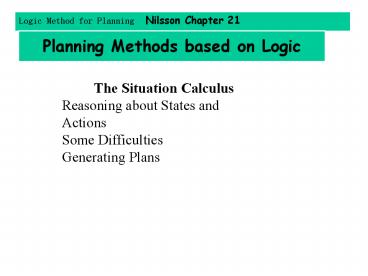Planning Methods based on Logic - PowerPoint PPT Presentation
1 / 15
Title:
Planning Methods based on Logic
Description:
Describe goal condition using any wff in predicate calculus. Describe world state using formulas ... Becomes unmanageable in realistic applications to express ... – PowerPoint PPT presentation
Number of Views:36
Avg rating:3.0/5.0
Title: Planning Methods based on Logic
1
Planning Methods based on Logic
The Situation Calculus Reasoning about States and
Actions Some Difficulties Generating Plans
2
Reasoning about States and Actions
- Describe goal condition using any wff in
predicate calculus - Describe world state using formulas
- Try to prove goal wff from formulas describing
world state - Predicate Calculus can be used to reason about
states and actions - Search is over a space of logical expressions
not a space of models of world states
3
Predicate Calculus formalization of states,
actions and the effects of actions on
states Knowledge about states and actions are
represented using formulas in FOPC Deduction
system ask questions e.g.Does there exist a
state such that it satisfies certain (goal)
properties, and if so, how can the present state
be transformed into that state by actions
? Answer Plan for achieving desired state
4
State S0
- Reify States include them into the world as
entities that exist (S0,S1,S2) - Change atomic wffs to include a term denoting a
state in which the intended relation holds - Interpretation of wffs relations over states
- wffs are called fluents . True for S0
- true of all states and
5
- Step 1 Reify the actions. Denote actions by
constants/ variable symbols/functional
expressions. Action is regarded as a function
involving entities. Example move(B,A,Floor)
action of moving B from A to
the Floor. - Step 2 Function constant do function that
maps actions and states into states.
maps the state-action pair into the
state obtained by performing the action
in the state - Step 3 Express effects of actions by wffs
called effect axioms
6
- Two wffs for each action-fluent pair For the
pair (On,move) - Positive effect axiom describes how an
action makes a fluent true - Negative effect axiom describes how an action
makes a fluent false
preconditions
7
- Two wffs for each action-fluent pair For the
pair (Clear,move) - Positive effect axiom
- Negative effect axiom
No action can make the floor not clear
8
On(B,A,S0)On(A,C,S0)On(C,Floor,S0)Clear(B,S0)C
lear(Floor,S0)
S0
move(B,A, Floor)
S1 do(move(B,A,Floor),S0)
Inferred using effect axioms substitution
B/x, A/y,S0/s, Floor/z
9
Frame Axioms
- Two wffs for each action-fluent pair For the
pair (move, On) describes fluent left unchanged
by an action - Positive frame axiom
- Negative frame axiom
10
More Frame Axioms
- Two wffs for each action-fluent pair For the
pair (move, Clear) describes fluent left
unchanged by an action - Positive frame axiom
- Negative frame axiom
11
Mapping a State-Action Pair into a State - Frame
Axioms
On(B,A,S0)On(A,C,S0)On(C,Floor,S0)Clear(B,S0)C
lear(Floor,S0)
S0
move(B,A, Floor)
S1 do(move(B,A,Floor),S0)
Inferred using frame axioms
12
Difficulties
The Frame Problem
- Two frame axioms for each action-fluent pair
- Becomes unmanageable in realistic applications
to express things that remain constant in the
world - Several techniques to reduce the number of frame
axioms but to reason about fluents that do
not change over sequence of actions remains
computationally cumbersome
13
The Qualification Problem
- Adding preconditions how do we know when we
have added all the pre-conditions/qualification
s ? - Attempts to solve this problem was made using
nonmonotonic reasoning allows default
conclusions in the effect axioms withdrawn
if further qualifications is added
14
The Ramification Problem
- In complex domains statements are often
deduced based on domain knowledge e.g. a
packet that a robot is carrying is in a room
if the robot itself is in the room - Can use different mechanisms to reason e.g.
first about the location of the robot, then
about the location of the package - How do we prevent the frame axioms from deducing
that the package is in a different room than
the robot (due to perceived consistencies ? - This problem is therefore how to keep track of
which derived formulas survive subsequent
state transformations
15
Generating Plans
- To generate a plan that achieves some goal
, attempt to prove and extract
the state as a function of the nested actions
that produce it - Proof effort becomes much too large for such a
simple plan - Frame problem made most attempts to use
situation calculus impractical































